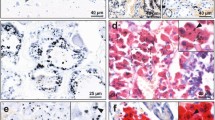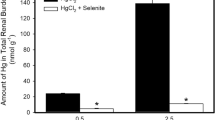Summary
The early renal excretion of mercuric mercury was studied in male BALB/c mice between 15 seconds and 30 min following a single intravenous injection of 3 mg HgCl2/kg body weight. The cytochemical Silver Amplification method applied at the light and electron microscopical levels showed mercury to be excreted by glomerular filtration and reabsorbed by proximal tubular epithelial cells by means of adsorptive endocytosis. Mercury was rapidly demonstrated in the lysosomal vacuome of proximal tubular epithelial cells. No uptake was observed from the peritubular side, and there was no evidence of tubular secretion of mercury.
It is proposed that mercury is excreted in the form of mercury-protein complexes, assisted by the physiological proteinuria in mice, which is enhanced by mercury-induced damage to the glomerular structures.
Similar content being viewed by others
References
Baumann K, Bode F, Ottosen PD, Madsen KM, Maunsbach AB (1980) Quantitative analysis of protein absorption in microperfused proximal tubules of the rat kidney. In: Maunsbach AB, Olsen ST, Christensen EI (eds) Functional ultrastructure of the kidney. Academic Press, London/New York/Toronto/Sydney/San Francisco, pp 291–301
Bergstrand A, Friberg L, Odeblad E (1958) Localization of mercury in the kidneys after subcutaneous administration. Arch Ind Health 17: 253–256
Berlin M (1979) Mercury. In: Friberg L, Nordberg GF, Vouk VB (eds) Handbook on the toxicology of metals. Elsevier/North-Holland Biomedical Press, Amsterdam/New York/ Oxford, pp 503–539
Berlin M, Gibson S (1963) Renal uptake, excretion, and retention of mercury. I. A study in the rabbit during infusion of mercuric chloride. Arch Environ Health 6: 617–625
Bode F, Ottosen PD, Madsen KM, Maunsbach AB (1980) Does transtubular transport of intact protein occur in the kidney? In: Maunsbach AB, Olsen TS, Christensen EI (eds) Functional ultrastructure of the kidney. Academic Press, London/New York/Toronto/ Sydney/San Francisco, pp 385–295
Bohman S-O, Maunsbach AB (1970) Effects on tissue fine structure of variations in colloid osmotic pressure of glutaraldehyde fixative. J Ultrastruct Res 30: 195–208
Bradford M (1976) A rapid and sensitive method for the quantitation of microgram quantities of proteins utilizing the principle of protein-dye binding. Anal Biochem 72: 248–254
Cember H, Gallagher P, Faulkner A (1968) Distribution of mercury among blood fractions and serum proteins. Am Ind Hyg Assoc J 29: 233–237
Christensen EI (1976) Rapid protein uptake and digestion in proximal tubule lysosomes. Kidney Int 10: 301–310
Christensen EI, Maunsbach AB (1980) Digestion of protein in lysosomes of proximal tubule cells. In: Maunsbach AB, Olsen TS, Christensen EI (eds) Functional ultrastructure of the kidney. Academic Press, London/New York/Toronto/Sydney/San Francisco, pp 341–359
Christensen EI, Carone FAC, Rennke HG (1981) Effect of molecular charge on endocytic uptake of ferritin in renal proximal tubule cells. Lab Invest 44: 351–358
Cikrt M, Heller J (1980) Renal tubular handling of203Hg2+ in the dog: A microinjection study. Environ Res 21: 308–313
Clarkson TW, Magos L (1970) Effect of 2,4-dinitrophenol and other metabolic inhibitors on the renal deposition and excretion of mercury. Biochem Pharmacol 19: 3029–3037
Danscher G (1981) Histochemical demonstration of heavy metals. A revised version of the sulphide silver method suitable for both light and electronmicroscopy. Histochemistry 71: 1–16
Danscher G (1982) Exogenous selenium in the brain. A histochemical technique for light and electron microscopical localization of catalytic selenium bonds. Histochemistry 76: 281–293
Danscher G, Schröder HD (1979) Histochemical demonstration of mercury induced changes in rat neurons. Histochemistry 60: 1–7
Danscher G, Möller-Madsen B (1985) Silver amplification of mercury sulphide and selenide: A histochemical method for ilght and electron microscopic localization of mercury in tissue. J Histochem Cytochem 33: 219–228
Dreisbach RH, Taugner R (1966) Renale „Stapelung“ und Ausscheidung von203Hg-Sublimat bei der Ratte. Nuclear Med 5: 421–435
Eneström S, Hultman P (1984) Immune-mediated glomerulonephritis induced by mercuric chloride in mice. Experientia 40: 1234–1240
Gayer J, Graul EH, Hundeshagen H (1962) Die Lokalisierung des Transportes von Hg2+ -Ionen in der Niere durch Stopflow-Analyse. Klin Wochenschr 40: 953–955
Hoffsten PE, Hill CL, Klahr S (1975) Studies of albuminuria and proteinuria in normal mice and mice with immune complex glomerulonephritis. J Lab Clin Med 86: 920–930
Hultman P, Eneström S (1983) Experimental Hg-nephropathy: correlation between histochemistry and analytical EM. J Ultrastruct Res 85: 1189–1190
James TH (1939) The reduction of silver ions by hydroquinoe. J Am Chem 61: 648–652
James TH (1977) The theory of the photographic process. Macmillan Publ Co, New York, ch 13
Jeppson JO, Laurell CB, Franzen B (1979) Agarose gel electrophoreses. Clin Chem 25: 629–638
Kempson SA, Ellis BG, Price RG (1977) Changes in rat renal cortex, isolated plasma membranes, and urinary enzymes following the injection of mercuric chloride. Chem Biol Interact 18: 217–234
Lippman RW, Finkle RD, Gilette D (1951) Effect of proteinuria on localization of radiomercury in rat kidney. J P Proc Soc Exp Biol Med 77: 68–70
Madsen KM (1980) Mercury accumulation in kidney lysosomes of proteinuric rats. Kidney Int 18: 445–453
Madsen M, Hansen HC (1980) Subcellular distribution of mercury in the rat kidney cortex after exposure to mercuric chloride. Toxicol Appl Pharmacol 54: 443–453
Mambourg AM, Raynaud C (1965) Etude, a l’aide d’isotopes radioactifs, du mechanisme de l’excretion urinaire du mercure chez le lapin. Rev Franc Etudes Clin Biol 10: 414–418
Maunsbach AB (1966a) Absorption of I125-labeled homologous albumin by rat kidney proximal tubule cells. A study of microperfused single proximal tubules by electron microscopic autoradiography and histochemistry. J Ultrastruct Res 15: 197–241
Maunsbach AB (1966b) The influence of different fixatives and fixation methods on the ultrastructure of rat kidney proximal tubule cells. 1. Comparison of different perfusion fixation methods and of glutaraldehyde, formaldehyde and osmium tetroxide fixatives. J Ultrastruct Res 15: 242–282
Maunsbach AB (1966c) Observations on segmentation of the proximal tubule in rat kidney. Comparison of results from phase contrast, fluorescence and electron microscopy. J Ultrastruct Res 16: 239–258
Maunsbach AB (1976) Cellular mechanisms of tubular protein transport. In: Thurau K (ed) Kidney and urinary physiology II, Int Rev Sci, Physiol, Series 2, vol 11. University Park Press, Baltimore, pp 145–167
McDowell EM, Nagle RB, Zalme RC, McNeil JS, Flamenbaum W, Trump BF (1976) Studies on the pathophysiology of acute renal failure. Correlation of ultrastructure and function in the proximal tubule of the rat following administration of mercuric chloride. Virchows Arch [Cell Pathol] 22: 173–196
Miller F, Palade GE (1964) Lytic activities in renal protein absorption droplets. An electron microscopical cytochemical study. J Cell Biol 23: 519–551
Nordberg GF, Skerfving S (1974) Metabolism In: Friberg L, Vostal D (eds) Mercury in the environment. CRC Press, Cleveland, Ohio [USA], pp 29–91
Pesce AJ, Hanenson I, Sethi K (1977) Beta2 microgloburinuria in a patient with nephrotoxicity secondary to mercuric chloride ingestion. Clin Toxicol 11: 309–315
Phillips R, Cember H (1969) The influence of body burden of radiomercury on radiation dose. J Occup Med 11: 170–174
Reuter AM, Hamoir G, Marchand R, Kennes F (1968) Isolation and properties of a mouse serum prealbumin excreted in urine. Eur J Biochem 5: 233–238
Rhodin J (1958) Anatomy of kidney tubules. Int Rev Cytol 7: 485–534
Rodin AE, Crowson CN (1962) Mercury nephrotoxicity in the rat. 1. Factor influencing the localization of the tubular lesions. Am J Pathol 61: 297–313
Rothstein A (1973) Mercaptans, the biological targets for mercurials. In: Miller MW, Clarkson TW (eds) Mercury, mercurials and mercaptans. Charles C Thomas Publisher, Springfield/ Illinois [USA], pp 68–166
Staemmler M (1956) Die akuten Nephrosen. I. Mitteilung. Die Sublimatnephrose. Virchows Arch [Pathol Anat] 328: 1–17
Straus W (1962) Colonmetric investigation of the uptake of an intravenously injected protein (horseradish peroxidase) by rat kidney and effects of competition by egg white. J Cell Biol 12: 231–246
Timm F (1958) Zur Histochemie der Schwermetalle. Das Sulfid-Silberverfahren. Dtsch Z Ges Gerichtl Med 46: 706–711
Vostal J, Heller J (1968) Renal excretory mechanisms of heavy metals. Transtubular transport of heavy metal ions in the avian kidney. Environ Res 2: 1–10
Wöckel W, Stegner H-E, Jänisch W (1961) Zum topochemischen Quecksilbernachweis in der Niere bei experimenteller Sublimatvergiftung. Virchows Arch [Pathol Anat] 334: 503–509
Zahne RC, McDowell EM, Nagle RB, McNeil JS, Flamenbaum W, Trump BF (1976) Studies on pathophysiology of acute renal failure. II. A histochemical study of the proximal tubule of the rat following administration of mercuric chloride. Virchows Arch [Cell Pathol] 22: 197–216
Author information
Authors and Affiliations
Additional information
Supported by grants from the Swedish Medical Research Council, Project 6536
Rights and permissions
About this article
Cite this article
Hultman, P., Eneström, S. & von Schenck, H. Renal handling of inorganic mercury in mice. Virchows Archiv B Cell Pathol 49, 209–224 (1985). https://doi.org/10.1007/BF02912098
Received:
Accepted:
Issue Date:
DOI: https://doi.org/10.1007/BF02912098




